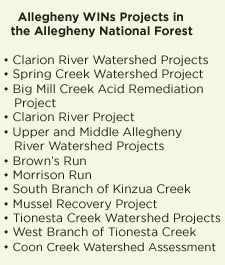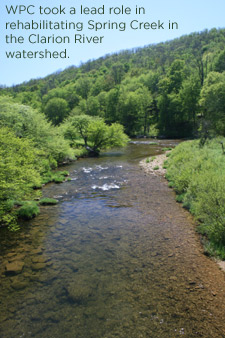
Like-Minded Organizations Align to
Protect Allegheny Watersheds
 Protecting and restoring the
watersheds of the half-million
acre Allegheny National Forest
Protecting and restoring the
watersheds of the half-million
acre Allegheny National Forest
is a daunting challenge – and one
that requires more resources than
any single conservation organization
can provide. However, new threats
to these watersheds make this
massive undertaking important, and
a broad partnership of like-minded
organizations makes it possible.
In April 2007, the Western
Pennsylvania Conservancy joined a
coalition of nonprofits, private
individuals, local watershed organizations
and local, state and federal
government agencies called The
Allegheny Watershed Improvement
Needs Coalition (Allegheny WINs).
The goal of Allegheny WINs is to
protect and improve the Allegheny
River and its primary tributaries, such
as Tionesta Creek and the Clarion
River, and to sustain the sport fish
and rare and endangered species
that share these waters.
Some of the threats that Allegheny WINs is addressing include:
- More than 6,000 miles of dirt and
gravel roads now penetrate the
Allegheny National Forest. The
roads affect fish and other aquatic
organisms in two ways. First,
eroding sediment kills small
organisms that serve as major food
sources for fish and chokes the
developing eggs of fish such as
brook trout. Second, the roads
disconnect upstream and
downstream habitats and cut off
fish movements, which can affect
reproductive cycles.
- Increased numbers of camp sites, gravel-based boat launches and all-terrain vehicle trails have caused sedimentation and erosion problems.
Nate Welker serves on the Ecosystems Management Team for the Allegheny National Forest and is responsible for bringing the coalition together. “For years, our organizations were all like ships passing in the night, occasionally getting together on a project, but never working in a concerted effort,” Welker said. “Now we meet regularly, work on active projects together and talk about potential projects. Anyone in the group can lead a project that draws on their expertise.”
Projects are currently underway
throughout the forest in the Clarion
River, Upper and Middle Allegheny
River and Tionesta Creek watersheds.
One of the key projects underway
by Allegheny WINs is Spring Creek.
Located in Forest and Elk counties in
the heart of the upper Clarion River
watershed, Spring Creek came to the
coalition’s attention because it was,
according to Welker, “in pretty bad
shape.” The Western Pennsylvania
Conservancy agreed to take the lead
in the Spring Creek project, which
focuses on the area near State
Gamelands No. 28. The goal is to
reduce sedimentation, rehabilitate
stream banks and remove barriers to
fish passage caused by roads that
now divide Spring Creek and its
tributaries.
”A lot of the old roads were built
out of necessity. Today, that’s
changing,” said WPC’s Upper
Allegheny Watershed Manager, Chuck
Williams, who is leading the Spring
Creek project. One of the tools
Williams uses to minimize fragmentation
of aquatic habitats is fairly simple,
a culvert: a pipe that is placed underneath
a road crossing to reconnect a
stream. “A properly placed and
sufficiently wide culvert can reintroduce
the headwaters with the main
stem of Spring Creek and enable
movement of aquatic life, while also
allowing movement of vehicles across
the stream.”
Financial support for the Spring
Creek project has been provided
by the Western Pennsylvania
Conservancy, Pennsylvania Game
Commission, Pennsylvania Fish &
Boat Commission, National Forest
Foundation, and the U.S.
Forest Service.
The coalition plans to conduct outreach and education campaigns targeting rural communities and young people as a means of improving water quality in the future.
Partners in the Allegheny
WINs Coalition |
|
| Nonprofits Allegheny Outdoor Club Brokenstraw Watershed Council Elk County Freshwater Association Kinzua Fish & Wildlife Association Pennsylvania Council of Trout Unlimited (Allegheny Mountain, Cornplanter, Black Cherry and Iron Furnace Chapters) Pennsylvania Environmental Council – Northwest Office The Nature Conservancy University of Pittsburgh, Bradford Campus – Environmental Studies Club Western Pennsylvania Conservancy – Allegheny Regional Office |
County Agencies Elk County Conservation District Elk County Planning Department Forest County Conservation District McKean County Conservation District Warren County Conservation District Warren County Adult Probation & Parole State Agencies Pennsylvania Department of Conservation and Natural Resources – Bureaus of State Parks and Forestry Pennsylvania Department of Environmental Protection – Northwest Regional Office Pennsylvania Department of Transportation – Engineering District 2-0 Pennsylvania Fish & Boat Commission – Division of Habitat Management Pennsylvania Game Commission – Bureau of Wildlife Habitat Management Pennsylvania State University – School of Forest Resources |
Federal Agencies |
|
Winter 2008 Conserve | Western Pennsylvania Conservancy | Fallingwater

